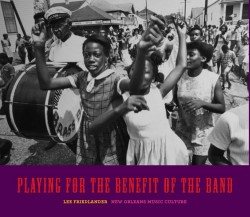 Last month Yale University Press released a book by the American photographer and artist Lee Friedlander. Friedlander, born in 1934, has spent years photographing the American social landscape, producing a vast amount of visual information. More than 20 books of his work have been published and this latest is called Playing for the Benefit of the Band. The title is from a 1958 interview with Warren “Baby” Dodds, one of the great drummers in jazz, now largely forgotten, conducted by the New Orleans historian, William Russell. An edited version this interview acts as an introduction to the book. In it Dodds says: “And that’s the way I play. I play for the benefit of the band.” (There’s a lesson there for more than a few drummers today.)
Last month Yale University Press released a book by the American photographer and artist Lee Friedlander. Friedlander, born in 1934, has spent years photographing the American social landscape, producing a vast amount of visual information. More than 20 books of his work have been published and this latest is called Playing for the Benefit of the Band. The title is from a 1958 interview with Warren “Baby” Dodds, one of the great drummers in jazz, now largely forgotten, conducted by the New Orleans historian, William Russell. An edited version this interview acts as an introduction to the book. In it Dodds says: “And that’s the way I play. I play for the benefit of the band.” (There’s a lesson there for more than a few drummers today.)
The subtitle of this book is New Orleans Music Culture and it is a collection of black and white photographs taken in New Orleans between 1957 and 1973. Many of the pictures are informal shots taken in the homes of the musicians, mostly players who did not join the exodus but remained part of the local scene, names such as Blind Freddie Small, “Show Boy” Thomas, Wooden Joe Nicholas, Ann “Mama Cookie” Cook; the exceptions being photos of Louis Armstrong, Edmond Hall, Wellman Braud, Roosevelt Sykes and George Lewis. There is also a charming outdoor crowd scene in the midst of which Duke Ellington is kissing Mahalia Jackson.
From the late 1800s there was music regularly in the Vieux Quartier … parades, street musicians, jazz bands on the backs of trucks and wagons. The tradition has survived and New Orleans, of course, is unique among cities in North America. Certainly in Toronto there is music of a kind, usually percussion every day at Dundas Square, but it can’t compare to the street music heard in the Crescent City. There used to be a healthy number of concerts in Toronto, co-sponsored by the city and the Toronto Musicians’ Association Trust Fund, but the fund ran short of money and our world-class city could not come up with the relatively small amount of support which in the past had given us concerts in parks and other city locations. So access to free concerts, be it jazz or a string quartet remains something to be desired.
There is another way of bringing jazz to a wide audience that has been lost and that is exposure in the mass media. The Globe and Mail and Toronto Star used to have regular articles on jazz by respected writers like Geoff Chapman and authors Mark Miller and Jack Batten. Now? Apart from the occasional obit it is easier to find a needle in a haystack than a jazz article in one of our dailies.
It’s a situation which underscores the need for and importance of publications like The WholeNote which every month provides a wealth of of information – articles on, and listings of, what is going on in the local world of jazz and classical music. Yes, there is the internet with lots of blogs, some of them excellent, and promotional info, but the fact remains that jazz is poorer than the proverbial church mouse when it comes to recognition by the mass media.
Some years ago when jazz in Toronto was on a high I heard us described as the New Orleans of the North. I’m afraid that we have gone West.
Closing food for thought: The music critic Henry Pleasants wrote: “Jazz may be thought of as a current that bubbled forth from a spring in the slums of New Orleans to become the mainstream of the 20th century.”
Enjoy the music you hear and try to hear some of it live.
Jim Galloway is a saxophonist, band leader and former artistic director of Toronto Downtown Jazz. He can be contacted at
jazznotes@thewholenote.com.



